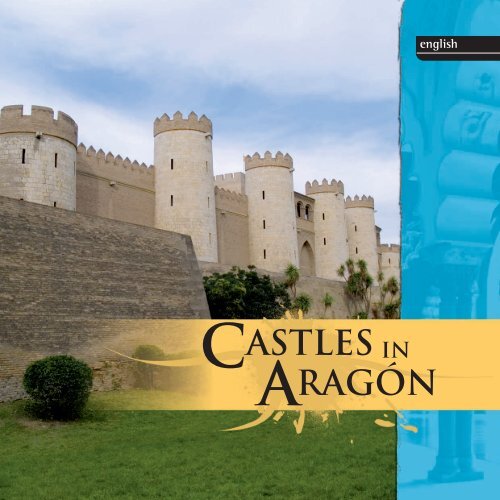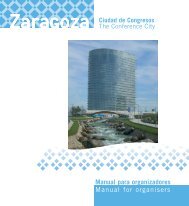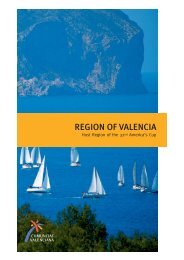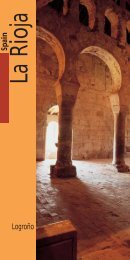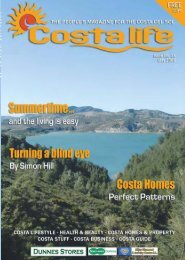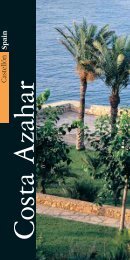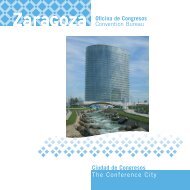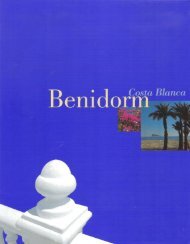CASTLES IN ARAGÃN - Tourismbrochures.net
CASTLES IN ARAGÃN - Tourismbrochures.net
CASTLES IN ARAGÃN - Tourismbrochures.net
Create successful ePaper yourself
Turn your PDF publications into a flip-book with our unique Google optimized e-Paper software.
english<br />
c astles in<br />
A RAGÓN
Front: La Aljafería, Zaragoza<br />
Sádaba Castle, Saragossa Peracense, Teruel Trovador Tower,, Aljafería Loarre Castle, Huesca<br />
A RAGÓN<br />
GENERAL <strong>IN</strong>FORMAtIoN<br />
Q<br />
w<br />
ELCOME to Aragon. Do you know where you are? You are<br />
in the Iberian Peninsula’s northeast. Its territory covers an<br />
area of more than 47,500 square kilometers and is made<br />
up of the provinces of Huesca, Saragossa and Teruel. More than<br />
1,200,000 inhabitants live here. They are friendly, noble and close.<br />
The best thing you can do is to get lost in this natural land, full of life<br />
and flavor. It has a border of 136 km with France, so you are in the<br />
central door to Europe from France and Portugal.<br />
It will take your breath away, but Aragon is a land that breathes<br />
history. If you follow the thousand-year-old marks, you will realize<br />
that, in this community of contrasts, Christians, Jewish and Muslims<br />
have lived together. Get ready because your adventure starts.
LISBOA<br />
l<br />
BELFAST<br />
ocation<br />
DUBL N<br />
LIVERPOOL<br />
MBURGO<br />
MSTERDAM<br />
LON O<br />
ERL N<br />
SELAS<br />
LUXEMBUR<br />
PARIS<br />
STRASBOURG<br />
MUNICH<br />
BERN<br />
BORDEAUX<br />
MILAN<br />
PAMPLONA<br />
PAU TOULOUSE<br />
MARSEILLE<br />
MADR D<br />
BARCELONA<br />
ROMA<br />
F R A N C I A<br />
P I R I N E O S<br />
JACA<br />
BENASQUE<br />
CET<strong>IN</strong>A<br />
Navarra<br />
TARAZONA<br />
TRASMOZ<br />
MESONES<br />
DE ISUELA<br />
ILLUECA<br />
CALATAYUD<br />
Guadalajara<br />
CALATAYUD<br />
DAROCA<br />
Cuenca<br />
SOS DEL REY<br />
CATÓLI O<br />
UNCASTILLO BIEL<br />
SÁDABA<br />
EJEA DE LOS<br />
CABALLEROS<br />
TAUSTE<br />
Zaragoza<br />
CALATORAO<br />
LA ALMUNIA<br />
DAROCA<br />
CARIÑENA<br />
CALAMOCHA<br />
PERACENSE<br />
ALBARRACÍN<br />
ALBARRACÍN<br />
Teruel<br />
JACA<br />
LOARRE<br />
ALJAFERÍA<br />
MONTAÑANA<br />
MONTALBÁN<br />
ESCUCHA<br />
SABIÑÁNIGO<br />
Huesca<br />
ALFAJARÍN<br />
ALBALATE<br />
SAMITIER<br />
ALQUEZAR<br />
ABIZANDA<br />
MONTEARAGÓN<br />
BARBASTRO<br />
MONZÓN<br />
MONZÓN<br />
ALCAÑIZ<br />
ALCALA<br />
DE LA SELVA<br />
MORA DE<br />
RUBIELOS<br />
CASPE<br />
CALANDA<br />
AÍNSA<br />
ALCAÑIZ<br />
FRAGA<br />
MEQU<strong>IN</strong>ENZA<br />
CASPE MAELLA<br />
Castellón<br />
MURO<br />
DE RODA<br />
FANTOVA<br />
Lérida<br />
Tarragona<br />
VALDERROBRES<br />
Evening at dusk in Loarre<br />
Valencia<br />
Castles in Aragón<br />
1
Skyscrapers<br />
of the history<br />
c astles<br />
of<br />
a ragón<br />
Q<br />
a<br />
RAGON is one of the seventeenth autonomous<br />
regions of Spain. It is located in the northeastern<br />
part of the Iberian Peninsula, in the middle of many<br />
things and always close. In its 47,724 square kilometers<br />
1,200,000 inhabitants live. Kind and friendly people, with a<br />
sarcastic humor and noble intentions, in a land with history.<br />
If you watch the sky, in Aragon, you will find natural mountains<br />
but also pieces erected by the man on mountain ranges and<br />
crags that, sometimes, merge with the earth. They are<br />
skyscrapers of the history; they are the castles of Aragon. Some<br />
persons say that there even were five hundred. Nowadays, quite<br />
a few still survive, some in perfect condition, others in ruins, but<br />
all of them riddled with secrets that have survived the passing of<br />
time. If they could speak…<br />
There are very clear origins, but other ones are not, as they mix<br />
facts and legends. Witnesses of wars, battles, skirmishes and<br />
uprisings, they amass historical and artistic wealth. There are<br />
humble ones or stylish, as the Romanesque, the Gothic, the<br />
Mudejar, the Renaissance and the Baroque embraced in them.<br />
Some were just control or defensive towers, others were real<br />
fortresses. Some combine the castle with a church, palace or<br />
convent, Muslim palaces or the typical French “donjon”.<br />
Are you ready to travel through time and let yourself be<br />
captivated by the castles of Aragon? The abandoned and the<br />
ones that have turn into a National Parador, also the ones that<br />
are the setting for the music, the theatre or to film a movie. Be<br />
careful because they will catch you.<br />
Ciudadela de Jaca (Citadel), Huesca<br />
2 Castles in Aragón
Sos Castle, Saragossa<br />
Aínsa, Huesca<br />
La Ciudadela de Jaca<br />
From a bird’s eye view, it seems to be a star. It is a perfect pentagon enclosed<br />
by walls, bastions, moats and other fortifications. The castle of San Pedro or<br />
Ciudadela (Citadel) is a military building that Felipe II ordered to build<br />
around 1592 in Jaca as a defense against a possible French invasion.<br />
However, as history would have it, it only did battle during the Independence<br />
War, when the Spanish tried to recover it after the Gallic occupation.<br />
The author of the plans was the commander Tiburcio Spanochi, who<br />
designed a castle that could hold up to one hundred garrison with great<br />
defensive details. Walls, scarps, and counterscarps, bastions with artillery<br />
emplacements…<br />
The moat is crossed by a bridge with three arches and by a drawbridge.<br />
After going through a door crowned by a shield, you will gain access to<br />
the inside where you should stop in front of the Baroque front that dates<br />
from the XVIII century and the parade ground that is riddled with arches.<br />
You can cover the entire perimeter along the sloping ground going for a<br />
pleasant walk and paying a visit to the deer family that lives in the moat,<br />
which is said not to have had water ever.<br />
Together with the Belgian one of Lieja, it is the only pentagonal castle that<br />
survives complete. La Ciudadela (the Citadel) is a National Monument and<br />
Nostra Europe Award but Jaca is much more. Disappear into its charms.<br />
Sos del Rey Católico<br />
Paved streets dotted with ancestral homes that will lead you until two<br />
hills. In one of them, the Sada Palace raises, birthplace of the Catholic King<br />
in 1452. In Peña Feliciana (crag), a privileged observation point, the Arabs<br />
built the original castle in the X century. Some two hundred years later,<br />
Ramiro II altered it. Observe that it is a walled building with an irregular<br />
plan and small dimensions whose heart is the Tribute Tower, which has a<br />
square plan. At the foot of it, as it was usual, a Romanesque church from<br />
the XIII century.<br />
Natural Fortress, Artistic Historic Collection, Sos, its castle, the<br />
Renaissance building of the Town Hall, the palaces, the guildhall an the<br />
rest of its proposals will captivate you.<br />
Aínsa<br />
Come round to Aínsa and disappear into this medieval town. Along its<br />
church, its streets, the Main Square but, above all, along its castle that still<br />
preserves remains from the XI century and remodeling from the XVI and<br />
XVII centuries.<br />
The fortress in nearly as big as the rest of the village. A thick wall<br />
dotted with high arches surrounds its rectangular courtyard. The bestpreserved<br />
building is the one that surrounds the Tribute Tower, which<br />
nowadays houses the Pyrenean Fauna Interpretation Centre. Far from<br />
making you feel like an oddball, this magical environment will take you<br />
to medieval periods.<br />
Sos was a vital strategic enclave between two kingdoms: Navarre and<br />
Aragon. Now, it is an unavoidable appointment. Surrounded by a medieval<br />
wall, Sos opens to you the seven doors that still preserves wide open.<br />
Castles in Aragón<br />
3
Biel<br />
Biel is located 760 m above sea level, surrounded by forests and,<br />
in the upper part, one can see its Romanesque tower that dates<br />
from the XI century.<br />
Enjoy watching the smooth walls with few a small windows,<br />
except in the western wall. Sancho Ramírez and his wife Felicia<br />
ordered to build it, the parents of the king Alfonso I el Batallador<br />
(the Battler). It is said that he spend most of his life in this place.<br />
Biel keeps many more surprises.<br />
Uncastillo<br />
Welcome to the village that is “a castle” or vice versa, whatever<br />
you prefer. The name of this Historic Artistic Collections says it<br />
all. Lifted up by Peña Ayllón (crag), the fortress dominates a<br />
lovely natural environment and the town that grows around it in<br />
concentric circles. Its six Romanesque churches, ancestral<br />
homes, and complex streets will bewitch you, making you feel as<br />
if you were in the Middle Ages.<br />
In the collection that occupies 6,500 square meters, the sturdy<br />
Tribute Tower, which has walls of more than one meter thick,<br />
stands out. Those certainly were walls. It is part of the defensive<br />
line that the King Sancho Garcés boosted in the X century in<br />
order to defend his dominions against the Muslim spread.<br />
Nowadays, it has turned into a museum.<br />
The Palace is Gothic, from the XIV century. Pedro IV ordered to<br />
build it with two hall floors covered by ribbed vaults. Between<br />
both buildings, lean out of a water well that is dug out of the<br />
rock. Do not miss any detail. Uncastillo has so much to show<br />
that, in the end, it is much more than “the castle”. It bewitches<br />
you during day or night.<br />
Narrow streets of Uncastillo, Saragossa<br />
Loarre<br />
With the sky as witness, dominated by the Mallos Kingdom, the<br />
Loarre castle is still standing, in good conditions, proud to be the<br />
most important Romanesque fortress of Spain and maybe of<br />
Europe. Eight towers, which still keep the sound of the swords,<br />
defend what was the royal palace, a convent and, more recently,<br />
a film stage. In Loarre, films like “Kingdom of Heaven”, by Ridley<br />
Scott, or “Miguel & William”, directed by Inés París, have been<br />
filmed, in which we find that many inhabitants of this area have<br />
shown that they are very good extras.<br />
4 Castles in Aragón
Walls and Loarre Castle, Huesca<br />
The Loarre castle, built in the XI century, has played several roles along its<br />
history. You will distinguish three constructive periods in it: With Sancho<br />
el Mayor arrive the upper building and the high towers; with Sancho<br />
Ramírez, the Royal Chapel and its surroundings; the impregnable wall<br />
dates from the XIII century. The stone cord that protects the entire<br />
collection with its two hundred meters long and its one meter and thirty<br />
centimeters thick will welcome you. The bridge with access to the Tribute<br />
Tower could be closed in order to leave this area isolated. It had<br />
dormitories, the kitchen, and warehouses to preserve the aliments.<br />
The most important piece in the premises is the Royal Chapel dedicated to<br />
Saint Peter. Take a good look. It ends in rich and sumptuous capitals,<br />
windows, dome, blind arches in the apse, and barrel and cul-de-four<br />
vaults. The Queen Tower, with a Mozarabic flavor, the same as in the Santa<br />
María church, is part of the original nucleus. Have a look out of La Reina<br />
Viewpoint and feel the world at your feet.<br />
In addition, in order to rest not only the feet but also the body and soul,<br />
the Loarre Guesthouse. It is located in a building that dates from the XVI<br />
century and it offers an intimate and relaxed environment under the<br />
attentive sight of the imposing castle.<br />
Samitier<br />
By the edge of the precipice but without loosing control. Over the vertical<br />
of the dam of the Mediano reservoir, it has been like this since the XI<br />
century, the military religious collection of Samitier. Ramiro I was the one<br />
that ordered to build it as a junction with the primitive border of Sobrarbe.<br />
In the access road, the chapel of Santa Waldesca will surprise you. In the<br />
amazing visit to the Samitier castle, you will check how important the<br />
balance is.<br />
With that name, you could not find but a spectacular fortress that dates<br />
from the XI century with a Romanesque church with three naves and a<br />
crypt. In other time, it was the political, religious, and military center of<br />
La Fueva Valley. It shows signs of the passage of time in its tired walls. It<br />
has been a privileged witness of most of the Aragonese history. Now, it is<br />
willing your seeing things from its privileged point of view.<br />
Castles in Aragón<br />
5
Sádaba<br />
You will find the Sádaba castle on a small hill. Sober and thick<br />
walls carved in stone, ashlars placed in horizontal rows that do<br />
only break their structure in order to form the towers with their<br />
battlements. The castle has a medieval style with Cistercian<br />
decorations from the XIII century. It is not the typical one. It does<br />
not have a tribute tower, a wall, or a moat. The loopholes and the<br />
openings are not shown often.<br />
It is not a pun. The walled building has a quite irregular<br />
rectangular plan. Around its courtyard, seven towers very<br />
different from one another and, again, with few openings. If you<br />
follow the narrow parapet walk that goes through the towers,<br />
you will arrive at an open-air hallway by which you can gain<br />
access to the parade ground. There, you will find a high-capacity<br />
water well. Let yourself be surprised.<br />
Moreover, if you want to stay, you can do it in the Sádaba<br />
Guesthouse, in Casa Cortés, a majestic building from the XIII<br />
century that offers the traveler warmth and comfort.<br />
Alquézar<br />
Its name in Arabic, Al- Qasr, means “The Fortress”. With its<br />
insulting beauty and like floating over the opening of the River<br />
Vero, you will be impressed by the image of its castle-collegiate<br />
church. There are Islamic remains, but also from the Christian<br />
Middle Ages in an area that rose as the border between Arabs<br />
and Christians. Versatile as few, it was a military watchtower at<br />
first, then, an ecclesiastical institution, and now, a natural<br />
paradise for tourists.<br />
In your visit, you will see the towers and barracks of the fortified<br />
collection. The Muslim castle of Alquézar was erected at the<br />
beginning of the IX century, Sancho Ramírez conquered it in the<br />
XI century, and he ordered to build the collegiate church f Santa<br />
María. The temple that there is nowadays dates from the XVI<br />
century, with a porticoed cloister that amasses remains of great<br />
value.<br />
Take down. Paintings, altarpieces, ancestral homes with their<br />
doorways, shields and rows of balconies and, the greatest work<br />
of art, is signed by the nature. If you want to, you can combine<br />
your walk along Alquézar with mystery, legends, or the charm of<br />
its people. You will leave willing to go back.<br />
6 Castles in Aragón<br />
Sádaba Castle, Saragossa<br />
Montearagón Castle, Huesca
Abizanda Castle, Huesca<br />
Fantova<br />
In the old County of Ribagorza, over the sky, the silhouette of Fantoya<br />
appears cut down, archetype of the Aragonese castle-church. Standing<br />
since the beginning of the XI century, a high tower with a circular plan<br />
and a Romanesque church with one nave perfectly integrated and adorned<br />
by a wall that is still mostly preserved.<br />
The tower has three floors. A groin vault covers the first one, in the second<br />
one there is a door in high, and the third one is decorated with seven<br />
semicircular openings. Elegant on a par with discreet.<br />
Abizanda<br />
The tower of the castle will welcome you when you arrive at Abizanda. You<br />
cannot miss it. A “donjon” from the XI is typical feudal. That is the name<br />
of those that have a tower, rooms and that serve as palace. All in one:<br />
watchtowers, viewpoints and residence in several floors. This one has five<br />
ended in a projection and a cute little balcony with views over Peña<br />
Montañesa and Monte Perdido.<br />
If we were to give a flavor to this short trip, it would be sweet honey and<br />
almonds from Abizanda.<br />
Montearagón<br />
You will be met by history. Sancho Ramírez and his son Pedro erected the<br />
castle of Montearagón in order to organize the siege and Reconquest of<br />
the city of Huesca. The father death due to an arrow wound, it would be<br />
Pedro I the one that was victorious in Los Llanos del Lacoraz.<br />
Sword went hand in hand with religion and, therefore, the fortress became<br />
a powerful monastery that started to decay due to the confiscation and a<br />
External premises of the Monzón Castle<br />
fire that broke out in the XIX century. In its splendor period, it had two<br />
buildings and ten towers. Nowadays and, waiting for better times, you can<br />
see the walled area, the watchtowers and tribute towers and the Baroque<br />
church. It is worth it.<br />
Monzón<br />
Merged into the landscape, its walls give an account of an interesting<br />
history. As the legend says, the king Sancho Ramírez paid some traitors for<br />
them to sneak in the Monzon castle. They made a bell ring in order for<br />
their occupants to believe that the Christian troops were inside. The<br />
surprise factor was decisive to conquer the castle on Saint John’s day, in<br />
1089. In honor to this saint, the Aragonese king ordered to build a temple<br />
that founded the Monzón kingdom.<br />
A kingdom that was living on a borrowed time until 1143. It was then<br />
when Ramón Berenguer IV gave the castle to the Knights Templar, turning<br />
into a temple. These monks-soldiers knew how to get the most of the<br />
fertile lands and, inside the fortress, they educated noblemen and princes<br />
like Jaime I el Conquistador (the Conqueror) or his cousin the Count of<br />
Provenza. The decline of the Knights Templar came in the XIV century and,<br />
afterwards, the hospitable people lived in the castle. After a period of<br />
inactivity, from the XVIII century, it turned into an artillery barracks.<br />
Now, its external appearance is relatively modern, from the centuries XVII<br />
and XVIII. In the entrance, two medieval buildings that are the Tower of<br />
Jaime I and a chapel-tower will welcome you. From the oldest, the Tribute<br />
Tower. Do also visit the Gentlemen Hall (Sala de los Caballeros) and the<br />
Rooms Tower (Torreón de las Dependencias). Five buildings, all of them<br />
independent. This is an example of those castles that appear on the books,<br />
with an irregular and dispersed plan that you cannot miss.<br />
Castles in Aragón<br />
7
Trasmoz Castle, Saragossa<br />
Illueca Castle, Saragossa<br />
Trasmoz<br />
Riddled with legends of witches and witches Sabbaths’, Trasmoz castle<br />
kept the limits of the Aragon kingdom during the XII and XIII centuries,<br />
sheltered by the magical Moncayo. It had two more centuries of splendor<br />
with the Luna and the Urrea families until, around 1530, a fire took its<br />
anger out on the majority of the building, and they left it. Nowadays, you<br />
have a restored tower at your disposal that houses a museum with the<br />
belongings of the last gentlemen.<br />
A legend says that the castle was built in a single night. You decide, once<br />
you are there, whether it is true or it is a superstition. The truth is that<br />
these lands bewitched Bécquer himself. Do you dare to?<br />
Illueca<br />
Have you heard about the pope Benedict XIII, the famous Papa Luna? Sure<br />
you have. He was born here in 1328, in the castle-palace of Illueca. In this<br />
time, the building had a different appearance from what you will find<br />
nowadays. How many races may he have run when he was a child in the<br />
open-air parade ground where many rooms lead.<br />
In the construction of the Illueca castle, you will notice a first stage that<br />
dates from the XIV and XV centuries, which gives the collection is exterior<br />
Mudejar appearance, a second Renaissance one, and a third one that adds<br />
the Baroque elements in the XVII century. More than a military fortress,<br />
you will think that you are before a palace. The truth is that it was both<br />
things.<br />
You can also stay, if you feel like, in the Guesthouse that occupies most of<br />
the castle’s rooms.<br />
Montañana<br />
In Montañana, a stone’s throw away from Saragossa, a medieval collection<br />
that preserves with difficulty the structure, remains of walls, towers and<br />
a bridge, is waiting for you. The passage of time has been inexorable but<br />
it withstands it and deserves your visit.<br />
Alfajarín<br />
Lifted up Montes Blancos (White Mountains), next to La Virgen de la Peña<br />
chapel, the castle of Alfajarín delights the sight of its silhouette to many<br />
cars that see it daily from the road. It was erected in the XI century and<br />
has an irregular plan, in a spur protected by cliffs and a moat to watch the<br />
Ebro riverbank and Saragossa from this area. It passed from Muslims to<br />
Christians and from Christians to Muslims repeatedly. Afterwards, it<br />
belonged to several baronies until it was deserted. The advance of the<br />
ruins does not make it loose its charm.<br />
Mesones de Isuela<br />
The castle-palace of the Luna family is one of the most magnificent ones<br />
that you can find in the Aragonese lands. It is lifted up a hill from where<br />
there is a view over the whole Mesones de Isuela. The original castle dates<br />
from the XI century but the work you are going to find dates from the XIV.<br />
A sturdy exterior building made of ashlar stone and reinforced with six<br />
cylindrical towers will attract your attention. And this even seeing that, in<br />
that period, the brick was in fashion. Among his gothic rooms, the one<br />
that served as chapel highlights. You will know of it when you look up to<br />
its beautiful Mudejar roof. Aragonese flavor.<br />
Papa Luna Castle-Palace, Illueca<br />
8 Castles in Aragón
Walls and courtyards of La Aljafería<br />
Aljafería<br />
As soon as you arrive at La Aljafería, you will check why it was<br />
once called “the Happiness Palace”. The Arabs built it in the XI<br />
century as a leisure paradise surrounded by vegetable gardens<br />
and irrigation channels, filling it with artists, scientists, and<br />
intellectuals. Can you imagine spending some time in this<br />
environment? After the Reconquest of Saragossa, it became the<br />
residence of the Christian monarchs. During the reign of Pedro IV<br />
el Ceremonioso (the Ceremonious) (1336-1387), La Aljafería<br />
turned into the most important political enclave of the city.<br />
The Catholic Monarchs ordered the biggest alteration in the XV<br />
century, making erect a luxurious palace on the Muslim walls. It<br />
was the seat of the Inquisition Court, with Felipe II the moat was<br />
added, and with Carlos III the barracks. Nowadays, it houses the<br />
Aragon Parliament, being witness of how the laws of this land<br />
are discussed and prepared.<br />
Open all year round for the one that want to come closer, it is an<br />
example or combination of cultures, religions, and coexistence.<br />
The Gothic-Mudejar church, next to the Trovador Tower<br />
(Troubadour) and Santa Isabel Courtyard (Patio de Santa Isabel),<br />
with its orange trees, small pools surrounded by porticos and<br />
plasterworks with Muslim flavor. A solemn staircase leads to the<br />
Catholic Monarchs’ palace, with its Throne Hall and other<br />
annexed large rooms. It is said that Santa Isabel of Portugal was<br />
born in one of the bed chambers of the palace. Look at the floor<br />
and at the coffered ceiling, enjoy each detail; become imbued<br />
with the magic that this work of art gives off.<br />
Calatorao<br />
It is said that Calatorao means “earth castle” and, even tough this<br />
locality is famous for its good stone, this fortress is made of brick<br />
and clayey mud wall. You will see that the walls are sturdy; they<br />
even are a meter and thirty centimeters thickness in some points.<br />
The inhabitants and the town council have plenty of plans for their<br />
castle of Muslim origin, which turned into a fortified palace<br />
around 1500. Its initial plan reminds to the Aljafería one; there are<br />
walls with a better quality than the ones of the church and more<br />
and less noble areas, like the servants’ ones. It seems that the<br />
Christians added the external brick surface, the well, and the<br />
Renaissance arches corridor. What is clear is that with those stone<br />
foundations from Calatorao, there is fortress for a long time.<br />
Castles in Aragón<br />
9
Puerta de Terrer in Calatayud, Saragossa<br />
Caspe, Zaragoza<br />
Mequinenza<br />
In the Ebro riverbank, this high white stone mass shows that the<br />
Aragonese lands end and the Catalan ones soon arrive. Another great<br />
strategic position. The Mequinenza castle-palace, one of the most<br />
dazzling from the Gothic in Aragon, is going to surprise you, located on a<br />
mountain. It was built in the XIV and XV centuries over an ancient Muslim<br />
castle, and it was refurbished in the XIX century. It has a polygonal plan<br />
and a high wall with six rectangular towers and one pentagonal. It has a<br />
central courtyard and rooms located around it. It belongs to the company<br />
ENHER and it is full of life.<br />
Calatayud<br />
There are many castles. Calatayud has five, united among them by a fourkilometer<br />
wall riddled with defensive towers, whose structure is mostly<br />
preserved, even seeing that it dates from the IX century. It has a reputation<br />
for being the oldest collection in Europe, so put on comfortable footwear<br />
and get ready to walk in the shade of its walls, erected in plaster mud wall.<br />
Observe the octagonal towers, the staircases between the walls, the<br />
vaults, and the domes. All this repeats itself some centuries afterwards in<br />
the Aragonese-Mudejar towers, about which Calatayud also boasts.<br />
Take delight in those five castles that seem to be made of natural rock,<br />
molten by the inexorable passage of time. The Ayub one, which has huge<br />
dimensions, which you could gain access to through some drawbridges,<br />
the Reloj one, the Torre Mocha one, the Peña one and the one of Doña<br />
Martina, which is the oldest one. In spite of its improvable state, its<br />
silhouettes still make the one that looks at them fall in love.<br />
Cetina<br />
Francisco de Quevedo got married in the oratory of the big Cetina castlepalace.<br />
The building has an elongated structure and ends in a tower in<br />
each end. The Tribute one is known as “el Volatín”. You will find the chapel<br />
in the oldest area of this monument with charm. It is standing since the<br />
XIII century. It was refurbished in the XV century and in the XX century, it<br />
was improved for you.<br />
Caspe<br />
You have an appointment with history. You will find the Gothic<br />
Compromiso castle, from the XIV century, by the edge of the cliff that gave<br />
onto the River Guadalope. You are in the official residence of the<br />
commanders of the San Juan de Jerusalén Order. In 1412, among these<br />
walls, the famous Compromise of Caspe was held, and the infante<br />
Fernando I de Antequera was crowned king.<br />
He was proclaimed new sovereign of the Aragon Crown very near here, in<br />
Santa María la Mayor Collegiate Church, which has a wonderful Gothic<br />
front as witness. If the stones spoke…<br />
10 Castles in Aragón
Albalate del Arzobispo<br />
Walls and views from Daroca, Saragossa Puerta Baja in Daroca, Saragossa<br />
From the XIII and XIV centuries, the wonderful ceiling of Albalate<br />
del Arzobispo is its Gothic castle, former mansion of the<br />
archbishops of Saragossa, lords of the place. Its name comes<br />
from there.<br />
It has a trapezoidal plan and was built in style. We should<br />
highlight the stately building where the palace’s chapel is<br />
located, which has a beauty roof and thin traceries in its ogival<br />
windows. Nevertheless, there is much more in this gem of the<br />
Gothic-Aragonese. The entire building is made of masonry,<br />
except the tower. Next to it, there is a bullring from 1992, whose<br />
main box you can gain access to from the castle. Amazing.<br />
Maella<br />
Two wide buildings of walls with turrets on the top make Maella<br />
a very special castle. It dates from the XV and XVI centuries, has a<br />
late Gothic style, and belonged to the Calatrava Order. By its side,<br />
a Gothic church with a classicistic front. It does not lack style.<br />
Daroca<br />
Daroca shows among stone walls with the stamp left by the<br />
Muslims, who founded the city in order to watch and defend the<br />
road to Valence. There are many churches but, nowadays, we<br />
take a good look at its fortified appearance, we go under the<br />
crenelated walls of Puerta Baja and the time travel begins. If you<br />
enter through Puerta Alta, either the Valence or the San Martín<br />
de Parra one, you will have the same feeling.<br />
Castles…there were three. The extensive towers of the Mayor<br />
nearly disappear into the eroded hill, from where there is a view<br />
over the collegiate church, but a pointed arch and its rectangular<br />
tower made of mortar and masonry will take you out of your<br />
confusion. If you want to see an amazing tower, have a look at<br />
the Andador one. This is what remains from the second castle, the<br />
San Cristóbal one, from the XIII and XIV centuries. The thirds one<br />
is La Juderia, which is also in ruins. Daroca sets people talking.<br />
Castles in Aragón 11
Alcañiz, Teruel<br />
Valderrobres, Teruel<br />
Alcañíz<br />
If you want a direct testimony of the XIII and XIV centuries, have a look at<br />
the scenes described in the Gothic frescos that are preserved in the<br />
Alcañiz castle-convent. To read in its walls is a complete privilege. These<br />
walls were built in order to be a domination element. Witness of conflicts<br />
and of the passage of time, it impresses for those things it keeps, for its<br />
big dimensions and for its height.<br />
It is known that is once was a castle with trapezoidal plan, but it was<br />
altered in the XVIII century and, nowadays, part of it has turned into a<br />
cozy National Parador. Luxury and comforts mix with the huge garden,<br />
what guarantees a very pleasant stay. Baroque palace, Romanesque<br />
chapel, Gothic Tribute Tower, Lanuza Tower… you have many things to see.<br />
Its origins, in which history and legend mix, are slightly confused, but all<br />
the styles embraced in this work. Take great pleasure.<br />
Valderrobres<br />
That one that goes along as if it owned the place by the middle of<br />
Valderrobles is the River Matarraña. If you lift your eyes, you will be<br />
captivated by the harmony in which the houses group in order to support<br />
the gothic collection of the episcopal castle-palace and the archpriestal<br />
church in high. With this amphitheater shape, it is said that, during the<br />
night, in the parade ground, one can hear the conversations of those that<br />
are sitting in the terraces of the Main Square.<br />
With so much tranquility, it still seems that the sessions of the Aragonese<br />
Courts resound, which were held in 1429 in the church of Santa María la<br />
Mayor. Alfonso V himself was presiding over some of them in the castle’s<br />
Courts Hall, November 12. As magnificent backdrop, three pointed arches<br />
with traceries in the large windows.<br />
In 1390, the archbishop of Saragossa ordered to erect his Gothic castle in<br />
Valderrobles, which had a noble nature. Two archbishops more and the<br />
Papa Luna kept on rounding off the work of the precursor. It has a<br />
hexagonal plan and the rooms are arranged around an open-air courtyard.<br />
The front is one of the most splendid ones of the civil Gothic in Spain. It<br />
ends in three crenelated towers, communicated by a parapet walk. If you<br />
want to, do not miss it and walk along the spectacular upper corridor that<br />
boasts about eleven semicircular arches. If it happens to be music or<br />
theatre inside it, you will think you are dreaming. It is delighful.<br />
Peracense<br />
It is said that is the guardian of the Menera mountain range, bronze over<br />
red. The origin of this fortress in not clear. It seems that it was the defense<br />
of a small medieval village known as La Villeta. It could have been a<br />
starting point for the royal troops toward the conquest of Albarracín.<br />
What you will see, was erected in the XIV century for military uses. From<br />
this strategic place, they were constantly watching the paths by which the<br />
Castilian troops could gain access. Protected by other close fortresses and<br />
lifted up on a precipitous crag, the Peracense castle is nearly t be used for<br />
the first time.<br />
12 Castles in Aragón
Peracense, Teruel Streets in Albarracín, Teruel Mora de Rubielos Castle, Teruel<br />
It is not a geologic mystery, explore it, and check that it has a generous<br />
irregular square plan that divides itself into three concentric buildings.<br />
However, always in a perfect balance, the various floors, the ammunition<br />
battalion, the dungeon, the stables, the kitchen, and the walls full of<br />
secret charms, coming one after the other. In its parade ground you will<br />
find some niches that might have been used to store provisions and for the<br />
warriors to shelter from cold. Nevertheless, the wall reinforced with three<br />
towers will give you a warm welcome. You will have to gain access though<br />
a narrow chink located by the edge of the precipice, 1,300 m above sea<br />
level, but quiet. Everything is under control.<br />
Albarracín<br />
When you arrive at Albarracín, you eyes will inevitably look toward the<br />
spectacular wall that protects a layout of winding streets that make up<br />
the urban area. It is unforgettable to contemplate the city from the<br />
battlements. The military residence of the Albarracín family, first Arab,<br />
then Christian, was situated on a high rock. Nowadays, the walls from the<br />
XIII century darken the castle’s ruins. Walking, walking… you will arrive at<br />
the highest tower of this Muslim tower, the Andador one, some remains<br />
of other castle. There even was a third one, the Muela one, but that one<br />
only remains in our memories.<br />
Alcalá de la Selva<br />
Located nearly 1,500 m above sea level, during winter, covered in snow,<br />
you will discover the Romanesque-Gothic castle of Alcalá de la Selva. The<br />
one you will see dates from the XII century, but it is situated on a previous<br />
Arab one. It might have been more a lord’s residence than a military<br />
building. Another attraction in the area with charm.<br />
Mora de Rubielos<br />
This really was to build in style. With a surface of 12,000 square meters,<br />
towers of more than 25 meters high and walls that exceed the five meters<br />
thick, the castle-palace of Mora de Rubielos is spectacular.<br />
It is Gothic, from the XIII century. Its solid ashlars give it a military<br />
external appearance, stuck together but imaginative as its four fronts are<br />
different. In the inside, the rooms are arranged around an open-air<br />
courtyard with porticoes that end in harmonious pointed arches. You will<br />
gain access through one of the towers. Do not choose the wrong one, as<br />
the other was used as a dungeon.<br />
This fortress has had to play various roles throughout its history: Military,<br />
collegiate church, palace, and convent, victim of a fire, the confiscation,<br />
and then the restoration for cultural purposes…. Nowadays, it is waiting<br />
for you, as well as the rest of the skyscrapers of the history of Aragon.
T ourist offices (open all year round)<br />
Aragón tourism office (OPEN ALL YEAR ROUND)<br />
Avda. César Augusto, 25. Tel. 976 28 21 81. ZARAGOZA<br />
www.turismodearagon.com<br />
PROV<strong>IN</strong>CE LOCALITY ADDRESS PHONE NUMBER<br />
Zaragoza Zaragoza Avda. César Augusto, 25 976 28 21 81 / 902 47 70 00<br />
Zaragoza Zaragoza Eduardo Ibarra, 3. Auditorio (Patronato Mpal. de Turismo) 976 72 13 33<br />
Zaragoza Zaragoza Glorieta Pío XII, s/n. Torreón de la Zuda 976 20 12 00 / 902 20 12 12<br />
Zaragoza Zaragoza Plaza de Nstra.Sra. del Pilar, s/n 976 39 35 37<br />
Zaragoza Zaragoza Estación Zaragoza-Delicias. Avda. de Rioja, 33 976 32 44 68<br />
Zaragoza Zaragoza Torre, 28 (S.I.P.A.) 976 29 84 38<br />
Zaragoza Zaragoza Plaza de España, 1. Cuarto Espacio (Patronato Prov. de Turismo) 976 21 20 32<br />
Zaragoza Alagón Plaza de San Antonio, 2 976 61 18 14<br />
Zaragoza Borja Plaza España, 1. Ayuntamiento 976 85 20 01<br />
Zaragoza Calatayud Plaza del Fuerte, s/n 976 88 63 22<br />
Zaragoza Caspe Plaza España, 1. Casa-Palacio Piazuelo Barberán 976 63 65 33<br />
Zaragoza Daroca Plaza de España, 4 976 80 01 29<br />
Zaragoza Gallocanta Mayor 976 80 30 69<br />
Zaragoza Mequinenza Plaza Ayuntamiento, 5 976 46 41 36<br />
Zaragoza Muel Taller-Escuela de Cerámica. Ctra. Valencia. Km 468 976 14 52 25<br />
Zaragoza Sádaba Rambla, s/n 976 67 50 55 / 699 42 58 34<br />
Zaragoza Sos del Rey Católico Palacio de Sada. Pza. Hispanidad 948 88 85 24<br />
Zaragoza Tarazona Plaza de San Francisco, 1 976 64 00 74 / 976 19 90 76<br />
Zaragoza Tauste Plaza de España, 1 976 85 51 54<br />
Zaragoza Uncastillo Santiago, s/n. Iglesia de San Martín de Tours 976 67 90 61<br />
Huesca Huesca Plaza Catedral, 1 974 29 21 70<br />
Huesca Abizanda Entremuro 974 30 03 26<br />
Huesca Aínsa Plaza del Castillo. Torre nordeste 974 50 05 12<br />
Huesca Aínsa Avda. Pirenaica, 1 974 50 07 67<br />
Huesca Barbastro Avda. La Merced, 64 974 30 83 50<br />
Huesca Benasque San Sebastián, 5 974 55 12 89<br />
Huesca Boltaña Avda. Ordesa, 47 974 50 20 43<br />
Huesca Canfranc-Estación Plaza del Ayuntamiento, 1 974 37 31 41<br />
Huesca Formigal Edificio Almonsa III 974 49 01 96<br />
Huesca Graus Fermín Mur y Mur, 25 974 54 61 63<br />
Huesca Jaca Avda. Regimiento de Galicia Local 2 974 36 00 98<br />
Huesca Monzón Plaza Mayor, 4 (Porches Ayto.) 974 41 77 74<br />
Huesca Monzón Castillo de Monzón 974 41 77 91<br />
Huesca Panticosa San Miguel, 37 974 48 73 18<br />
Huesca Sabiñánigo Plaza de España, 2 974 48 42 00<br />
Huesca Torreciudad Santuario de Torreciudad 974 30 40 25<br />
Teruel Teruel San Francisco, 1 978 64 14 61<br />
Teruel Albarracín Diputación, 4 978 71 02 51<br />
Teruel Alcañíz Mayor, 1 978 83 12 13<br />
Teruel Alcorisa Plaza de San Sebastián, 1 978 84 11 12<br />
Teruel Andorra P.º de las Minas, s/n. Bajo 978 88 09 27<br />
Teruel Beceite Villaclosa, 9 978 89 04 68<br />
Teruel Calamocha Pasaje Palafox, 4 978 73 05 15<br />
Teruel Cantavieja Plaza Cristo Rey, s/n 964 18 52 43<br />
Teruel Castellote Nueva, 47 978 88 75 61<br />
Teruel Galve Rambla San Joaquin, 2 (Museo) 978 77 60 47<br />
Teruel Molinos Antiguos Lavaderos, s/n 978 84 90 85<br />
Teruel Rubielos de Mora Plaza Hispano América, 1 978 80 40 01<br />
Teruel Torrevelilla San José, 7 978 85 24 62<br />
Teruel Valderrobres Avda. Cortes de Aragón, 7 978 89 08 86<br />
Diseño e impresión: San Francisco, S.L. • Fotografía: Archivos y Pablo Murillo • Depósito Legal: Z-3.427/2006<br />
TOURIST <strong>IN</strong>FORMATION PHONE NUMBER: 902 477 000


